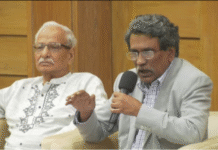As Siem Reap facility opens, PM Hun Manet looks for more Belt and Road money

Cambodia’s new airport in Siem Reap has begun operations and an inauguration event is scheduled for November. (Screenshot from Cambodian Prime Minister Hun Manet’s Facebook page)
PHNOM PENH — Planes have begun landing at a new Chinese-built airport near the city of Siem Reap, the latest symbol of how Cambodia is pinning its hopes for infrastructure investment on its political and economic patron.
The Siem Reap-Angkor International Airport, built over three years at a cost of about $1 billion, began operations last week ahead of its official inauguration next month.
Cambodia has received billions in infrastructure funding from China. Much of it, including the new airport, has come under the banner of the Belt and Road Initiative (BRI), the overseas infrastructure-building project that Chinese President Xi Jinping has nurtured over the past decade.
Attending a BRI forum in China last week, Cambodian Prime Minister Hun Manet signed several memorandums of understanding about potential projects.
Manet met top political officials and representatives of state-owned companies, including China Machinery Engineering Corporation (CMEC), China National Energy Engineering & Construction (CNEE), China Datang Corporation, Genertec International, and China Railway Construction Corporation (CRCC).
The meetings covered plans to invest in renewable energy, the gas sector, a data management center, water supply upgrades and new rail links.
Speaking with CRCC chairman Wang Jianping, Manet discussed modernizing Cambodia’s existing rail network and connecting it to the city of Bavet on its eastern border with Vietnam, and with the tourist hub of Siem Reap.
Manet also met with Li Kuo, chairman of China Metro Group, which is interested in building light rail connections to the Siem Reap airport and another under construction in Phnom Penh.
“The Belt and Road Initiative has been instrumental in providing many developing countries, including Cambodia, with numerous advantages such as the development of physical infrastructure, increased foreign direct investments, economic growth, regional and global integrations and people-to-people exchanges,” Manet said in a speech at the event.
The new 700-hectare airport is around 40 kilometers from Siem Reap and was developed by a consortium of state-owned companies from China’s Yunnan province. The consortium will run the facility under a 55-year build-operate-transfer deal.
It was built to handle 7 million passengers a year, with potential for expansion, and serves as the gateway to the Angkor Wat temple complex, Cambodia’s biggest tourism draw. The country has been attempting to win back visitors after years of COVID-related disruption, including with a campaign focused specifically on Chinese tourists.
The airport replaces one run by French conglomerate Vinci, which was situated just 5 km from the world heritage-listed site, a proximity that presented problems, said Sinn Chanserey Vutha, a spokesman for Cambodia’s Secretariat for Civil Aviation.
These included a difficult approach path for pilots during some months and concerns that increasing the number of flights could impact the temples.
It was also too close to residences to allow for expansion, necessitating the move to another site, whose distance from Siem Reap was in line with international norms, Vutha said. Tokyo’s Narita airport, he pointed out, is even further from the center of the city it serves.
To move forward on the Siem Reap airport, the government had to end the agreement governing operation of the previous facility many years early.
The previous facility was run by Cambodia Airports, 70% owned by Vinci Airports and 30% by a Malaysian-Cambodian joint venture. Vutha said a committee set up to sort out compensation awarded $63 million for the early termination.
The new operator, Angkor International Airport Investment, is a consortium of Yunnan Investment Holdings, Yunnan Construction Investment Group and the Yunnan Airport Group. The consortium was also given control of the old airport, but Vutha said it has yet to propose another use for the site.
Vinci had operated all of Cambodia’s international airports — Phnom Penh, Siem Reap and Sihanoukville — under concessions awarded in the 1990s that were supposed to run until 2040.
Its concession in Phnom Penh will also likely be cut short, with a new $1.5 billion airport overseen by local conglomerate Overseas Cambodia Investment Corporation expected to come online in 2025.
Vutha said Vinci was in discussions with Cambodia Airport Investment, the special project vehicle in charge of the development, about whether they would play a role in the future facility.
“These are [business-to-business] discussions. How far they reached, we don’t know,” he said.
Cambodia Airports spokesman Norinda Khek said it was continuing with further development of the Sihanoukville site and had “engaged in constructive dialogue with involved parties on the new Phnom Penh airport project.”












